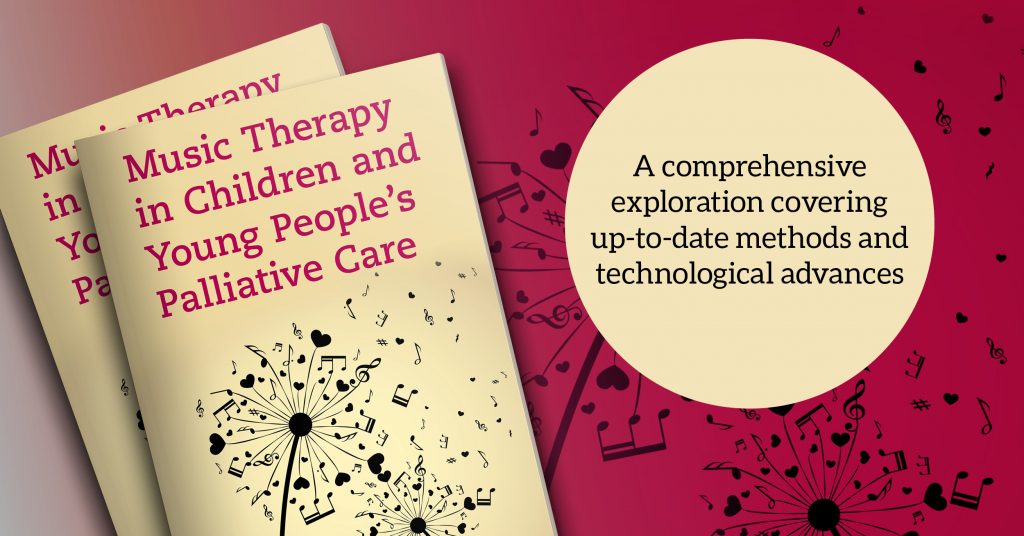To mark World Music Therapy Day, we are sharing an extract from Anna Ludwig’s book, “Music Therapy in Children and Young People’s Palliative Care“.

Meeting Joe
At the time I worked with him, Joe was 11 years old. Born with cardiofaciocutaneous (CFC) syndrome, Joe had a challenging start to life that was further impacted on by meningitis at ten months old, resulting in brain damage. Life from then on had been in and out of hospital, and Mum had been advised on five occasions to turn off his life-support machine, after which each time he had continued to live on. After the most recent occasion, Mum had been told that there was ‘nothing there’ and not to expect any form of intentional response or communication from Joe.
During my initial visit Mum told me about the lists of things that she had been told Joe could not do, including uncertainty around hearing and sight. Joe would likely not enjoy having his hands touched due to regular bloods, cannulas and steroid injections, and Mum was not expecting anything from music therapy other than to provide him with a different form of stimulation other than herself. Due to a history of difficult times in school, including returning one day with broken legs, Joe was now home-schooled and Mum chose to have full responsibility for all his medication and physiotherapy.
There was an anxiety surrounding allowing another person into their home who would have contact with Joe, and Mum asked me, ‘Have you ever worked with a child like Joe?’ I had been used to working in special schools where I had a range of instruments I could draw upon at any moment and a piano with which I felt very comfortable creating music that would hold a client and reflect the smallest of gestures – physical or emotional. I replied saying that I had but that everyone was different, and we would get to know each other over the next few weeks.
In our first sessions I found myself desperately trying to find ways of getting a response from Joe that would give me an insight into the way he communicated. I would watch his monitors, looking for changes in oxygen levels and heart rate, and sang lots of songs that gave him opportunities to respond and communicate choice. I would offer a choice between two instruments, and over time I noticed that Joe’s still response and blank face were for when he did not want something, and during music that he wanted more of he could become very animated, including lifting his arms and laughing.
Mum was thrilled at his response and commented that this was the first time in his life that he had been given choice and it was now something that she too felt confident to do, knowing that this choice was intentional and not something that she was seeing because she wanted to. It felt good that Mum was positive about the sessions and had been empowered to try things herself; however, I found myself feeling as if I was playing at Joe and not sitting with him as he was. I had somehow fallen into the box of another professional attempting to see what was there. It felt awkward and false, like a performer experimenting on their audience. It was not a mutual relationship of respect, which I believed was most therapeutic.
Six sessions in we were in the middle of one of our ‘faster or slower’ games when Joe became so excited he was struggling to breathe. The monitor alarms started going off and I could feel Mum getting anxious behind me. I gradually slowed things down but there was no effect. I put down the instruments, took a breath and sang a long vowel sound. Within the chaos of alarms and panic I held single notes for as long as I could, making my intake of air as steady as the sound that was produced on the out breath. Gradually I saw Joe’s eyes begin to flicker as if I was speaking to him for the first time. His eyes opened wide and the monitors stopped sounding.
His oxygen saturation levels were beginning to increase, and Mum began to sit back down. Joe listened. His eyes were the most animated I had seen them. Slowly he opened his mouth and I changed my vowel sound to reflect his mouth shape as it changed. Then, suddenly, as if from nowhere, a small sound came from him. Initially the sound was so small it almost made me stop breathing to listen; I could feel Mum freeze in disbelief. I responded, mirroring Joe’s vowel sound and adding a note to fall to. Joe responded again, this time stronger, and gradually we sang in dialogue with each other. For the first time I felt we were working together in a mutual relationship. I felt as if I was saying, ‘Hello, nice to meet you, tell me about it, I’m here and I’m listening.’ When we stopped, Mum expressed her amazement at and disbelief in what had happened. She had been told that having a relationship and vocalising with someone in this way was something Joe was not capable of.
Written by chapter author, Kirsty Ormston.